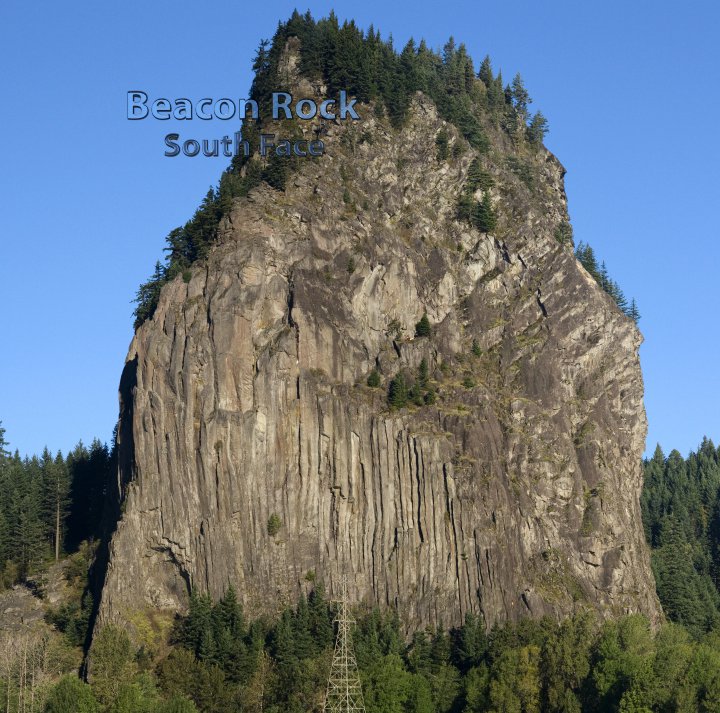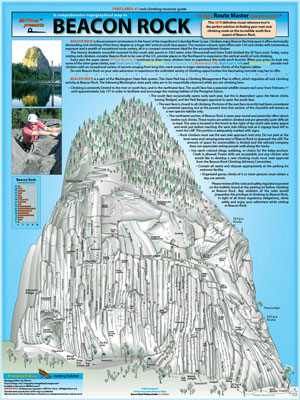The sport of rock climbing at Beacon Rock provides climbers with great opportunities to experience the taste of 'big wall' climbing on a small Southwest Washington scale. Supporting the economic vitality of the Beacon Rock State Park and promoting an environment open to all visitors ultimately serves all of our best interests. This section covers the nature of rock climbing on the south face aspect of this monolith. See our JPEG image of the south face Beacon Rock BR South Face (jpg), or the PDF version of the same image BR SF PDF.

Beacon Rock is the prominent centerpiece in the heart of the magnificent Columbia River Gorge and a very unique treasure in an extensive Washington State Park. This State park provides a multitude of activities from camping, boating, hiking, horse riding including rock climbing.
Portland climbers could not have asked for a finer big wall crag than Beacon Rock. Beacon offers technically demanding and sustained dihedral rock climbing of the finest degree on a huge 400' vertical south face aspect. The rock routes here offer tremendous exposure and variety that will surely test the limits of any strong climber.
Beacon Rock is the second largest monolith in the world, and it is the eroded core of an old volcanic neck. The 848-foot high spire is composed of light colored vesiculed Andesite, and is steeply featured on all sides. This steepness provides climbers with one of the finest opportunities near Portland to experience technically demanding, multi-pitch climbing.
Every year the super classic SE Face Route (5.7) continues to draw many climbers here to experience this multi-pitch favorite. When you arrive do look into some of the other great climbs, too! Dod's Jam (5.10C), Free For All (5.8), Free For Some (5.11A), Blownout (5.10A), Right Gull (5.10A), Left Gull (5.10A), and Pipeline (5.11B) provide rock climber's with an exceptional variety of climbs ranging from long thin crack routes to major stemming corners of the highest caliber.
Rock climbing routes on the south aspect of Beacon Rock range in technical difficulty from 5.7 to the upper 5.12+ grade.
A concentration of 10 to 15 lead climbs exist per grade from 5.9 to 5.11B. These core mid-range routes provide an excellent opportunity to define your climbing experience.
Beacon Rock today offers hikers a summit trail with sweeping scenic views of the entire Columbia River Gorge. Captivating scenic views of the very heart of the Columbia River Gorge are part of the unique experience you will find when climbing here! Do visit Beacon Rock on your next climbing adventure to experience the challenge and to capture the prize.
Sunset Wall: this is the southwest aspect of Beacon Rock in front of the west talus field. A string of new mixed bolt/trad routes are being established here. Wise to wear a helmet if climbing on Sunset Wall (the hikers trail is directly above your head and tourists have been known to chuck stuff.) One advantage is that this southwest facing aspect of Beacon Rock is open year-round (thus no seasonal closure).
Beacon has enchanted, and hauntingly enticed generations of adventurers even before the first ascent of the SE Face in April of 1954 by John Ohrenschall and Gene Todd. This historical monument of rock was referred to as 'Beacon Rock' and 'Beaten Rock' by Lewis and Clark while on their cross-country Corp of Discovery expedition of 1805-1806 to the Pacific Ocean. Later, in 1811 it attained the name 'Inshoack Castle', but generally was known as 'Castle Rock' until 1916 when the U.S. Board of Geographic Names reestablished the original name. In 1915 Henry J. Biddle initiated the building of the present day trail which leads to the summit of the rock. In 1935 the rock was established as part of the Washington State Park System, so that all could enjoy the beauty and wonder of this majestic monolith. This monolith was known as Che-che-optin to the indigenous regional Indians tribes.
Chances are, if you’ve climbed at Beacon Rock over the past three decades or so, you’ve met, talked to, heard about, or even tied in with one of the giants of Northwest climbing, Jim Opdycke.
 Born April 25, 1944, Opdycke first made it to the top of Beacon Rock when he was just five months old. Literally. A picture from the fall of 1944 shows baby Opdycke and his family atop the monolith after hiking all the way up the trail. But it wasn’t until forty years later that Opdycke really began to make his mark at Beacon Rock.
Born April 25, 1944, Opdycke first made it to the top of Beacon Rock when he was just five months old. Literally. A picture from the fall of 1944 shows baby Opdycke and his family atop the monolith after hiking all the way up the trail. But it wasn’t until forty years later that Opdycke really began to make his mark at Beacon Rock.
In the interim, Opdycke grew up in Vancouver. In 1967, he hit the road, thumbing his way around the country for three years before returning home and joining the workaday world. An inveterate adventurer, Opdycke needed more, so in 1972 he started climbing mountains. Over the next four years, he embarked on some hardcore mountaineering, heading to the hills in the harshest of conditions to sharpen his skills and learn how to survive.
And then in 1976, Opdycke’s friend, Jay Kerr, introduced him to rock climbing, first at Broughton Bluff near Troutdale and then at Beacon Rock. At Beacon, the two climbed all the way to the top via a wet, dirty 5.10c known as Seagull. Opdycke was hooked.
Though he continually climbed all around the west — Yosemite, Devil’s Tower, Colorado, Arizona, Alaska, Oregon, Idaho, and Washington — Opdycke eventually found his true calling at Beacon Rock. After being injured in a fall in 1984, Opdycke headed out to Beacon to find the rock dirty, overgrown, and largely silent. Many of the pioneers from earlier decades had backed off by then, but Opdycke saw that there was still plenty of trail to blaze at Beacon. He began solo aiding up some of the lines he’d always wanted to do, cleaning them all the way up, adding solid bases down below. He would take friends out to Beacon and turn them on to his routes; he’d also listen to what other climbers had to say about his routes, whether they were any good or not.
Over the ensuing years, Opdycke put up some of the most classic routes at Beacon Rock: Young Warriors, Little Wing, Jill’s Thrill, Ground Zero, Stardust, and Cruisin’ to name a few. In total, he has put up close to 4,000 feet of new routes at Beacon Rock.
Yet beyond just his climbing at Beacon, Opdycke is known as well for his stewardship of the place. Always friendly and encouraging to up-and-coming climbers — a mentor even — he has logged countless hours cleaning and tending to routes at Beacon. On opening day every year, he’s almost always the one who cleans the Southeast Corner and gets it in shape for the season to come. And even if he’s not climbing when he’s at Beacon, Opdycke’s likely doing something to make it better: battling poison oak, picking up trash, shoring up a base. It’s what he loves to do, not only because he reveres Beacon Rock, but because he wants other people to be able to have the same adventures out there that he’s had.
So the next time you head out to Beacon, keep your eyes and ears open for a wiry, mustachioed man with the hands of a climber and an easy, enthusiastic smile. He’s part of the reason you’re there.
Article written by Jon Bell for inclusion in the Beacon Rock chapter, Portland Rock Climbs 4th edition.
An effective and useful tool for every rock climber

This informative reference map is formulated to enhance the unique characteristics of the south face aspect of Beacon Rock. The map brings all the pertinent rock climbing route information into a compact foldable map that is easy to carry in your pack or pocket. Search no further for books to carry, because here at your fingertips is the perfect solution to finding your next rock climbing route at Beacon Rock. The climbing map is printed on water/tear resistant plastic stock.
Beacon Rock is a part of the Washington State Park System, which does have a Climbing Management Plan in effect to regulate rock climbing. The following are some of the most pertinent of the Beacon Rock State Park regulations to be observed:
- Rock climbing is limited to the river or south face and to the northwest face. The south face aspect is open for rock climbing from approximately July 15th until January 31st. The south face is typically closed from February 1st until July 14th, but may open a little early or later. These dates are dependant upon the fledgling timeframe of the young falcons and the Park Managers approval. The seasonal south face closure helps to protect the Peregrine Falcon nesting habitat.
- The east face is closed to all climbing. Although portions of the east face of Beacon Rock were considered for potential opening, plant species and falcon activity necessitates a year-round closure of the east side.
- The northwest section of Beacon Rock is open year-round and presently offers more than a dozen rock climbs (see the 4th edition of PRC). This area is located entirely in the forest starting at a sign to the right of the water spigot at the parking lot, and ending where the hiking trail zigzags back to meet the wall. This area is posted with signs describing where the climbing off limits.
- Rock climbers must use the east side approach trail only. Do not park at the boat ramp/camping area west of Beacon Rock to approach the cliff. The railroad company does not like climbers walking along its tracks.
- Use gray colored slings or webbing for the belay anchors. Chalk use is allowed. Bolting is allowed as specified in the climbing management plan, but any climber who wants to develop a new climbing route must file an application and first attain approval from the Park Manager.
- Guided group climbs of 6 or more persons must obtain a day use permit.
Any violation of the rules could jeopardize the privilege of climbing on Beacon Rock. Review the State Park Internet web-site, the bulletin board near the climbers trail, or check with the park manager for further information. The Washington Administrative Code for technical rock climbing can be viewed online at WAC Title-Chapter-Section 352-32-085.
There are several objective dangers while climbing on the south face of Beacon Rock, poison oak and rock fall.
Rock fall is generated from above near the west side hiking trail at a point above the third tunnel where sightseers gather. Above the Southeast Face route climbers occasionally stir up trouble when dragging the rope through loose rocks on Grassy Ledges.
Numerous instances of close calls due to stone fall have occurred. Because there is a risk of encountering rock fall while at the base of the cliff climbing helmets are highly recommended for personal safety. If other people are known to be climbing above you on the Southeast Face or Right Gull, take extra precaution.
The other problem is seasonal, and it is Poison Oak. Usually, long pants will suffice. Learn to recognize the three-leaf pattern and color. Some of the climbing routes up left of the Arena of Terror are virtually unclimbable because of the poison oak. Take the necessary precautions and learn to avoid both problems while climbing here.
When climbing at Beacon Rock competency is a must! Climbing here is not for beginners or to learn basic skills. Many of the routes are multi-pitch and quite challenging while the scenery in the Columbia Gorge is superb, all good reasons to visit Beacon Rock.
The directions are as follows:
Here is a Road/Trail Map.
From Vancouver, Washington drive east on State Route 14 for 28.8 miles to Beacon Rock State Park.From Portland, Oregon you can drive east on I-84 to Cascade Locks crossing the Bridge of the Gods, then drive 7 miles west on State 14 past Bonneville Dam to Beacon Rock.
For those who are driving in from east side Cascade Mountains points-of-origin: Use either State Route 14 or I-84.
Park at the east end of the parking lot near the restrooms, review the park regulations, and then walk down the east side climber's trail to access the climbs on the south face. This trail gently zigzags downhill beneath the great east face overhangs to the south face.
An overview map to the right will assist you when approaching the crag. In 2006 the parking fees were rescinded, but in 2011 the parking fees were re-established. To approach the river face climbing area walk down the east side climber's trail to access the south face of Beacon Rock.
